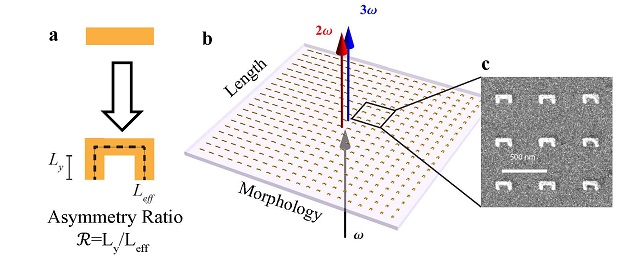 "Confocal microscopy confirmed that the nonlinear optical properties of metamaterials can be predicted using a theory about light passing through nanostructures."
"Confocal microscopy confirmed that the nonlinear optical properties of metamaterials can be predicted using a theory about light passing through nanostructures."
Researchers at the University of California Berkeley and the Lawrence Berkeley National Laboratory (Berkeley Lab) used a new theory for non-linear light scattering to show that non-linear optical properties of metamaterials can be predicted easily. The study has been described in the journal Nature Materials.
Metamaterials offer promising applications in superfast optical computers and high resolution optical microscopes. These materials are artificial nanostructures and have unique electromagnetic properties. However, in order to tap the huge potential of metamaterials, researchers would need to improve their understanding of the basic physics. This would involve precise prediction of non-linear optical properties of metamaterials. This means, interaction with light alters the properties of a material, for instance, the light which is emitted from the material will have a different frequency than when it entered the material.#
Metamaterials’ electromagnetic properties are attributed to their physical structure more than their chemical composition. For instance, this structure gives a negative refractive index to certain metamaterials. Refractive index is an optical property wherein the phase front light traveling via a material spreads backward towards the source. The phase front of light traveling via natural materials only spreads forward, that is, away from its source.
The research team has already leveraged the linear optical properties of metamaterials to produce a novel optical invisibility cloak and imitate black holes. Recently, the researchers utilized a non-linear metamaterial having a zero refractive index to create “phase mismatch–free non-linear light,” which means light waves traveling via the material get strength in all directions. On the other hand, designing non-linear metamaterials is still at the nascent stage, with no overall conclusion on the correlation between non-linear and linear properties.
Over the past few years, researchers applied the “Miller’s rule,” formula to predict the non-linear optical characteristics in natural crystals. However, in the latest study carried out by Zhang and other researchers Miller’s rule does not work for several metamaterials. Nevertheless, a non-linear light scattering hypothesis, developed by Dutch scientist Sylvie Roke for nanostructures, works well.
To that end, Zhang, Suchowski, O’Brien, and other researchers assessed the non-linear light scattering theory and Miller’s rule by comparing their experimental results and predictions achieved through a non-linear stage-scanning confocal microscope. Confocal microscopy was used to view the second harmonic generation from arrays of metamaterial whose structure changed slowly from a uniform bar-shape to an irregular U-shape.
Second harmonic light is a kind of non-linear optical property, wherein photons exhibiting the same frequency network with a non-linear material to create new photons at half the wavelength and double the energy of the originals. The optical second harmonic generation was discovered in 1961 and this led to modern non-linear optics.
The key question has been whether one can determine the non-linear behavior of metamaterials from their exotic linear behavior. We’ve shown that the relative non-linear susceptibility of large classes of metamaterials can be predicted using a comprehensive non-linear scattering theory. This will allow us to efficiently design metamaterials with strong non-linearity for important applications such as coherent Raman sensing, entangled photon generation and frequency conversion, said Xiang Zhang, lead researcher and director of Materials Sciences Division of Berkeley Lab and also an international authority on metamaterial engineering.
Zhang is also a member of Berkeley (Kavli ENSI)’s Kavli Energy NanoSciences Institute and holds the Ernest S. Kuh Endowed Chair at University of California Berkeley. He is also the corresponding author of the paper titled “Predicting non-linear properties of metamaterials from the linear response.” Other authors include Xiaobo Yin, Kevin O’Brien, Boubacar Kante, Alessandro Salandrino, Junsuk Rho, and Haim Suchowski.
From the linear properties, one calculates the nonlinear polarization and the mode of the nanostructure at the second harmonic. We found the nonlinear emission is proportional to the overlap integral between these, not simply determined by their linear response.
Kevin O’Brien, co-lead author of the Nature Materials paper and a member of Zhang’s research group
Our results show that non-linear scattering theory can be a valuable tool in the design of non-linear metamaterials not only for second-order but also higher order non-linear optical responses over a broad range of wavelengths. We’re now using these experimental and theoretical techniques to explore other non-linear processes in metamaterials, such as parametric amplification and entangled photon generation, O’Brien further added.
The U.S. Department of Energy (DOE) Office of Science supported the research.
This News Featured Around the Web
References